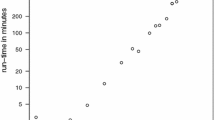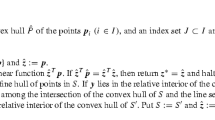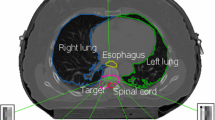Abstract
A relaxed version of Karmarkar's method is developed. This method is proved to have the same polynomial time complexity as Karmarkar's method and its efficient implementation using inexact projections is discussed. Computational results obtained using a preliminary implementation of the method are presented which indicate that the method is practicable.
Similar content being viewed by others
References
I. Adler, N. Karmarkar, M.G.C. Resende and G. Veiga (1986), “An implementation of Karmarkar's algorithm for linear programming,” Manuscript, Dept. of Industrial Engineering and Operations Research, University of California, Berkeley, CA (1986).
K.M. Anstreicher, “A monotonic projective algorithm for fractional linear programming,”Algorithmica 1 (1986) 483–498.
E.R. Barnes, “A variation on Karmarkar's algorithm for solving linear programming problems,”Mathematical Programming 36 (1986) 174–182.
R.G. Bland, D. Goldfarb and M.J. Todd, “The ellipsoid method: a survey,”Operations Research 29 (1981) 1039–1091.
T.M. Cavalier and A.L. Soyster, “Some computational experience and a modification of the Karmarkar algorithm,” The Pennsylvania State University, ISME Working Paper 85–105 (1985).
K.R. Frisch, “The logarithmic potential method of convex programming,” Memorandum of May 13, 1955, University Institute of Economics, Oslo, Norway.
D.M. Gay, “A variant of Karmarkar's linear programming algorithm for problems in standard form,”Mathematical Programming 37 (1987) 81–90.
P.E. Gill, W. Murray, M.A. Saunders, J.A. Tomlin and M.H. Wright, “On projected Newton barrier methods for linear programming and an equivalence to Karmarkar's projective method,”Mathematical Programming 36 (1986) 183–209.
D. Goldfarb and S. Mehrotra, “A self-correcting version of Karmarkar's algorithm,” Manuscript, Industrial Engineering and Operations Research Department, Columbia University (1986).
D. Goldfarb and S. Mehrotra, “Relaxed variants of Karmarkar's algorithm for linear programs with unknown optimal objective value,”Mathematical Programming 40 (1988) 183–195.
D. Goldfarb and J.K. Reid, “A practicable steepest-edge simplex algorithm,”Mathematical Programming 12 (1977) 361–371.
P. Huard, “Resolution of mathematical programming with nonlinear constraints by the method of centres,” in: J. Abadie, ed.,Nonlinear Programming (North-Holland, Amsterdam, 1967) pp. 207–219.
N. Karmarkar, “A new polynomial-time algorithm for linear programming,”Combinatorica 4(1984) 373–395.
L.G. Khachian, “A polynomial algorithm in linear programming,”Doklady Akademiia Nauk SSSR Novaia Seriia 244 (1979) 1093–1096. [English translation inSoviet Mathematics Doklady 20 (1979) 191–194.]
L.G. Khachian, “Polynomial algorithms in linear programming,”USSR Computational Mathematics and Mathematical Physics 20 (1980) 53–72.
I.J. Lustig, “A practical approach to Karmarkar's algorithm, Report SOL 85-5, Department of Operations Research, Stanford University (Stanford, CA, 1985).
S. Mehrotra, “Variants of Karmarkar's algorithm: Theoretical complexity and practical implementation,” Ph.D. Thesis, Industrial Engineering and Operations Research Department, Columbia University (1987).
B.A. Murtagh and M.A. Saunders, “Large-scale linearly constrained optimization,”Mathematical Programming 14 (1978) 41–72.
W. Orchard-Hays,Advanced Linear Programming Computing Techniques (McGraw-Hill, New York, 1968).
M. Padberg, “A different convergence proof of the projective method for linear programming,”Operations Research Letter 4 (1986) 253–257.
C.C. Paige and M.A. Saunders, “LSQR: An algorithm for sparse linear equations and sparse least-squares,”ACM Transactions on Mathematical Software 8 (1982) 43–71.
D.F. Shanno, “Computing Karmarkar projections quickly,” Working Paper 85-10 Graduate School of Administration, University of California (Davis, CA, 1985).
D.F. Shanno and R.E. Marsten, “On implementing Karmarkar's method,” Working Paper 85-01, Graduate School of Administration, University of California (Davis, CA, 1985).
J.M. Todd and B.P. Burrell, “An extension of Karmarkar's algorithm for linear programming using dual variables,”Algorithmica 1 (1986) 409–424.
J.A. Tomlin, “An experimental approach to Karmarkar's projective method for linear programming,”Mathematical Programming Study 31 (1987) 175–191.
R.J. Vanderbei, M.S. Meketon and B.A. Freedman, “A modification of Karmarkar's linear programming algorithm,” Manuscript, AT&T Bell Laboratories (Holmdel, NJ, 1985), to appear inAlgorithmica.
D.B. Yudin and A.S. Nemirovskii, “Informational complexity and effective methods of solution for convex extremal problems,”Ekonomika i Matematicheskie Metody 12 (1976) 357–369. [Translated in:Matekon 13 (1977) 24–45.]
Author information
Authors and Affiliations
Additional information
This research was supported in part by NSF Grants CDR 84-21402 and DMS-85-12277 and ONR Contract N00014-87-K-0214.
Rights and permissions
About this article
Cite this article
Goldfarb, D., Mehrotra, S. A relaxed version of Karmarkar's method. Mathematical Programming 40, 289–315 (1988). https://doi.org/10.1007/BF01580737
Received:
Revised:
Issue Date:
DOI: https://doi.org/10.1007/BF01580737




